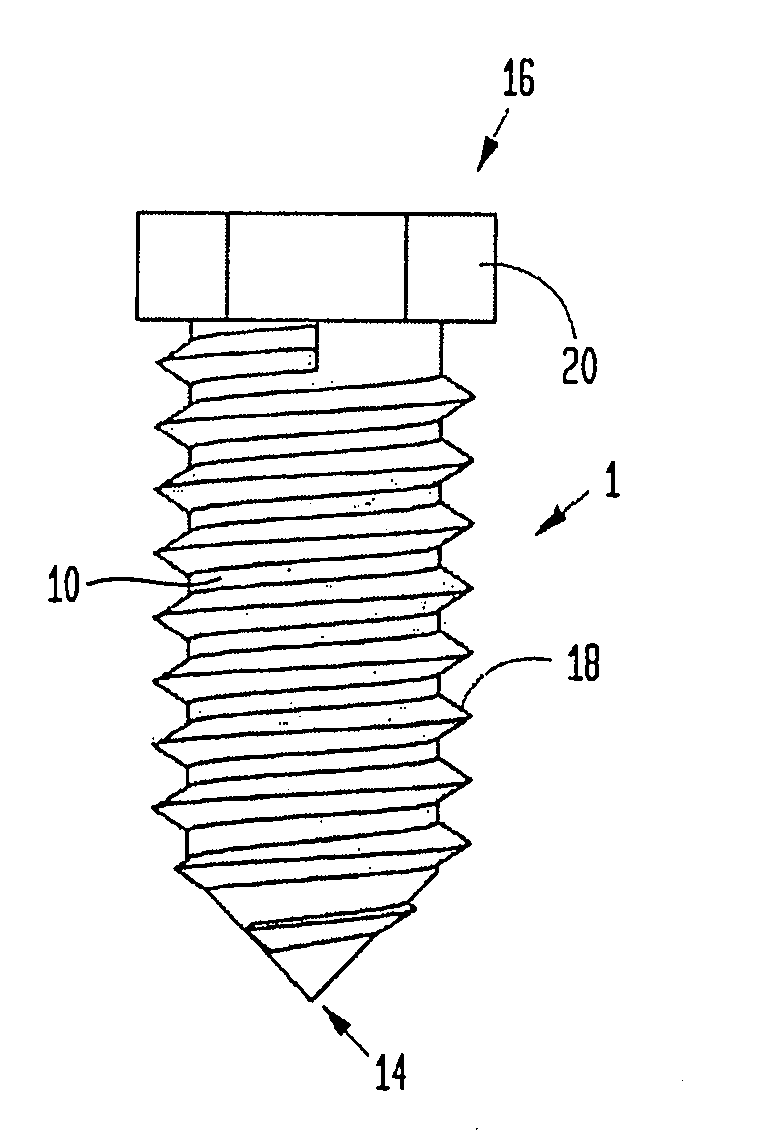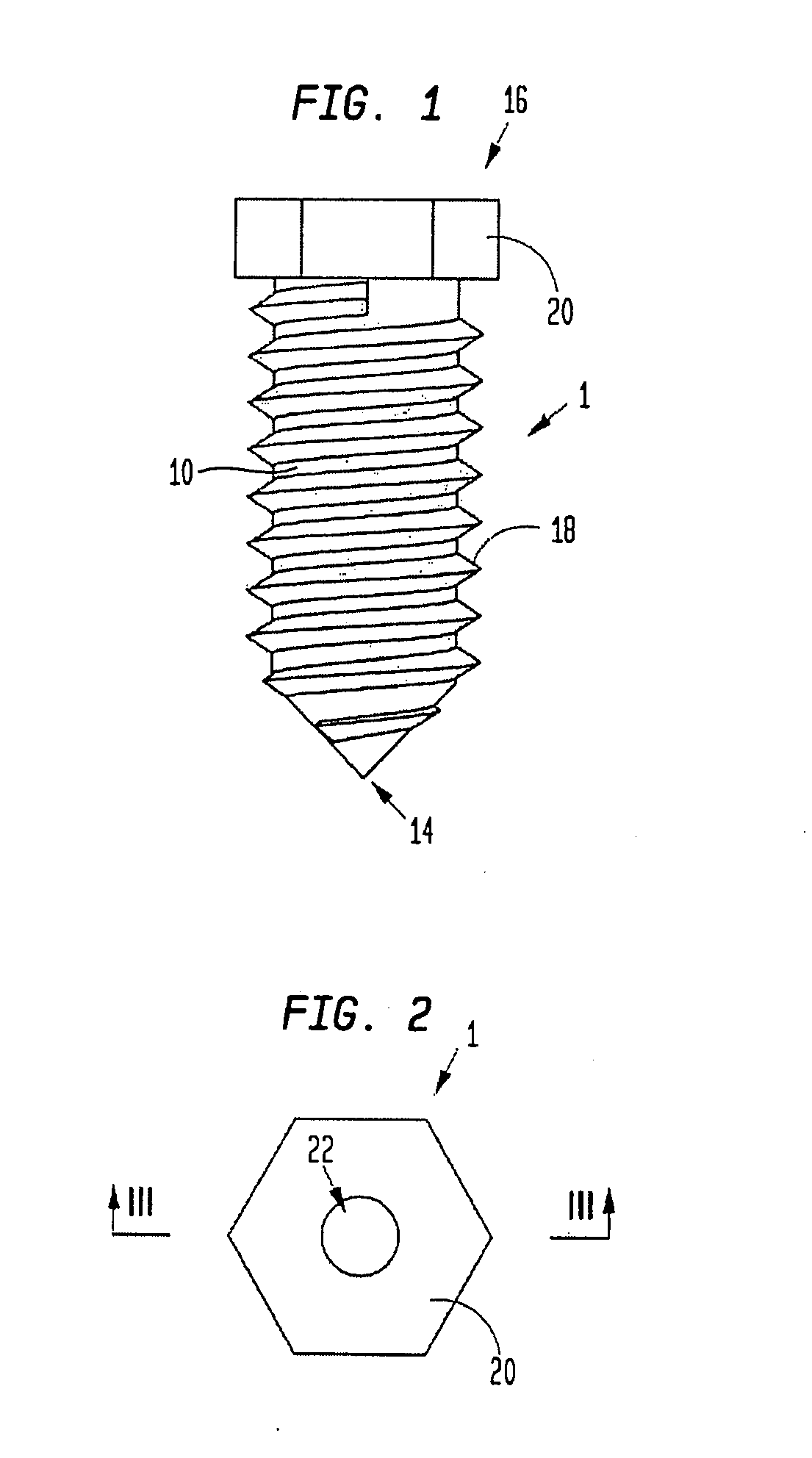Medical device and procedure for attaching tissue to bone
a technology of tissue and bone, applied in the field of medical devices and procedures for attaching tissue to bone, can solve the problems of pain, shoulder instability and/or restricted arm movement, various difficulties, etc., and achieve the difficulty of positioning the anchor device in the hol
- Summary
- Abstract
- Description
- Claims
- Application Information
AI Technical Summary
Problems solved by technology
Method used
Image
Examples
first embodiment
[0059]A medical system in accordance with the present invention comprises two primary components, namely, a bone anchor device 1 as shown in FIGS. 1-4 and a tissue fastener device 2 as shown in FIGS. 5-7.
[0060]Referring initially to FIGS. 1-4, a bone anchor device 1 in accordance with the invention is shown for anchoring a suture that is engaged with soft tissue to a bone. It includes a substantially cylindrical body 10 and an eyelet pin 12. Both the anchor main body 10 and the eyelet pin 12 may be formed of a biocompatible material, such as of a type already commonly used within the body of a person, e.g., a metal or metal alloy such as titanium, stainless steel or cobalt-chrome alloys; a suitable polymeric material that is nonabsorbable, such as polyethylene, poly-ether-ether-ketone (PEEK), poly-ether-aryl-ketone (PEAK); a resorbable polymer selected from homopolymers, copolymers and blends of polylactide, polyglycolide, polyparadioxanone, polytrimethylene carbonate or polycaprola...
third embodiment
[0101]Referring now to FIGS. 21 to 25 of the drawings, a bone anchor device 300 for anchoring a suture engaged with soft tissue to a bone in accordance with the invention includes a substantially cylindrical body 340 (shown in FIGS. 21-23) and an eyelet pin 342 (shown in FIG. 24). Both the anchor main body 340 and the eyelet pin 342 can be formed of materials equivalent to those referred to above. The anchor main body 340 again defines an operative leading (or distal) end 344 and an operative trailing (or proximal) end 346 and a self-tapping thread 348. At its trailing end 346, the body defines a geometrically profiled formation 50 that permits engagement with a screwdriver-type tool for screwing the body into a bone. For the purpose described hereafter, the effective diameter of the formation 350 is equal to or smaller than the diameter of the remainder of the anchor main body 340. The body 340 again defines a receiving formation 352 that is in the form of a cylindrical blind bore,...
second embodiment
[0107]FIGS. 27 and 28 illustrate a fifth procedure or procedure step envisaged for performing a rotator cuff repair in accordance with the present invention and using the bone anchors of the present invention. FIGS. 27 and 28 illustrate this procedure utilizing the bone anchor 200 of the second embodiment illustrated in FIGS. 19 and 20 and provides for the anchor main body 210 to be screwed into the humerus 70 in a desired anchoring location. Prior to being screwed into the humerus, the anchor main body 210 has an eyelet pin 212 partially located therein, the eyelet pin 212 carrying a suture 72 as shown. It must be appreciated in this regard that the eyelet pin and suture also can be so placed immediately after the location of the anchor main body 210.
[0108]Following the location of the anchor main body 210 as shown and in order to provide for the required location of a damaged tendon 74 with respect to the humerus 70 with the aid of a suitable arthroscopic passing instrument, one e...
PUM
 Login to View More
Login to View More Abstract
Description
Claims
Application Information
 Login to View More
Login to View More - R&D
- Intellectual Property
- Life Sciences
- Materials
- Tech Scout
- Unparalleled Data Quality
- Higher Quality Content
- 60% Fewer Hallucinations
Browse by: Latest US Patents, China's latest patents, Technical Efficacy Thesaurus, Application Domain, Technology Topic, Popular Technical Reports.
© 2025 PatSnap. All rights reserved.Legal|Privacy policy|Modern Slavery Act Transparency Statement|Sitemap|About US| Contact US: help@patsnap.com



